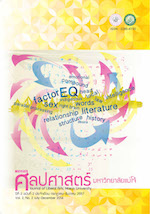รูปแบบการเขียนในกฎหมายล้านนาโบราณ (Style of legal structure in Ancient Lanna Law)
Main Article Content
Abstract
การวิจัยครั้งนี้มีวัตถุประสงค์เพื่อรวมรวมและจำแนกประเภทตามชื่อของกฎหมายล้านนาโบราณ และศึกษารูปแบบการเขียนในกฎหมายล้านนาโบราณแต่ละประเภทที่มีการปริวรรตเป็นอักษรไทยกลางแล้ว จำนวน 22 ฉบับ ผลการศึกษาพบว่า กฎหมายล้านนาโบราณสามารถแบ่งออกได้เป็น 8 ประเภทได้แก่ 1) ธรรมศาสตร์ 2) มังรายศาสตร์ 3) ธรรม 4) อวหาร 5) มังรายธรรมศาสตร์ 6) หนังสืออนุโลมญาณกฎหมายโบราณ 7) หัตถกัมม-วินิจฉัยบาฬีฎีการอมสมมุติราช 8) กฎหมาย ด้านรูปแบบการเขียนสามารถแบ่งออกได้เป็น 3 ส่วน ได้แก่ ส่วนต้น ส่วนเนื้อหา และส่วนท้ายส่วนต้นนั้นพบว่ามีรูปแบบการเขียน 2 รูปแบบ ได้แก่ 1) แบบที่ 1 กล่าวถึงพระยามังรายและความยิ่งใหญ่ของพระยามังรายในกฎหมายประเภทมังรายศาสตร์ 2) แบบที่ 2 เป็นส่วนประณามพจน์ที่กล่าวบูชาพระรัตนตรัยในกฎหมายประเภทธรรม ส่วนเนื้อหานั้นพบว่ามี 3 ลักษณะ ได้แก่ 1) ลักษณะที่ใช้บทบัญญัติทางกฎหมายตัดสินความเพียงอย่างเดียว 2) ลักษณะที่ใช้เรื่องเล่าตัดสินคดีความเพียงอย่างเดียว 3) ลักษณะที่ใช้บทบัญญัติทางกฎหมายและเรื่องเล่าตัดสินคดีความ สำหรับส่วนท้ายนั้นพบว่ามีรูปแบบการเขียน 8 รูปแบบ ได้แก่ 1) การกล่าวจบ 2) การบอกวันเวลาที่คัดลอก 3) การบอกจุดประสงค์ในการคัดลอก 4) การบอกสถานที่คัดลอก 5) การบอกชื่อผู้คัดลอก 6) การกล่าวออกตัวของผู้คัดลอก 7) การบอกที่มาของเอกสารที่คัดลอก 8) การกล่าวถึงลำดับการครองราชย์
This research aims to collect and devide name of ancient Lanna law and study form of ancient Lanna law. The information related to 22 of ancient Lanna law manuscripts in this research have already been transliterated into central Thai language. The study found that the ancient Lanna law can be categorized into eight kinds: 1) Dhammasastra, 2) Mangrai, 3) Dhamma, 4) Avahara, 5) Mangraidhammasastra, 6) Nangsueanulomyankotmaiboran, 7 )Hathakammavinitchaibaleedeekaromsommuthiraj and 8)Kotmai. In term of form, it can be divided into 3 parts, that is, introduction, content, and conclusion. It is found that there are 2 forms of introduction, 1) the mention of King Mangrai and his greatness in Mangrai law, 2) the worship and praise of the Tri Gems in Dhamma Law. In terms of content, there are 3 characteristics, 1) law provisions for verdict, 2) the usage of tales for verdict, and 3)law provision for the usage of tales for verdict. For conclusion, there are 8 types, namely, 1) ending remarks, 2) citing date and time copied, 3) copying objectives, 4) indicating copying site, 5) indicating names of copier, 6) copiers’ apology, 7) indicating sources of the copied manuscript, and 8) indicating lineage of accession to throne.
Article Details
Section
Research Articles
ต้นฉบับที่ได้รับการตีพิมพ์ในวารสารคณะศิลปศาสตร์ มหาวิทยาลัยแม่โจ้ ถือเป็นกรรมสิทธิ์ของมหาวิทยาลัยแม่โจ้ ห้ามนำข้อความทั้งหมดหรือบางส่วนไปพิมพ์ซ้ำ เว้นเสียแต่จะได้รับอนุญาตจากมหาวิทยาลัยฯ เป็นลายลักษณ์อักษร

